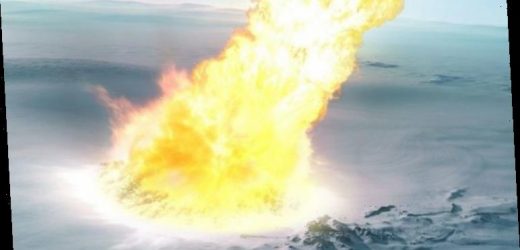Asteroid: Expert explains how ‘Earth defence simulations' work
When you subscribe we will use the information you provide to send you these newsletters.Sometimes they’ll include recommendations for other related newsletters or services we offer.Our Privacy Notice explains more about how we use your data, and your rights.You can unsubscribe at any time.
Scientists have discovered evidence of an asteroid impact in Antarctica 430,000 years ago. The asteroid is believed to be around 100 metres wide and exploded before it made landfall. A team of international scientists found evidence of “extraterrestrial particles” on a 2,500 metre-tall mountain summit in Antarctica which suggest something not of this world hit.
A statement from the University of Kent said: “Extraterrestrial particles (condensation spherules) recovered on the summit of Walnumfjellet (WN) within the Sør Rondane Mountains, Queen Maud Land, East Antarctica, indicate an unusual touchdown event where a jet of melted and vaporised meteoritic material resulting from the atmospheric entry of an asteroid at least 100 m in size reached the surface at high velocity.”
To further compound the asteroid theory, scientists noted meteoric material which had been vaporised on impact.
The university added that chondritic bulk major, trace element chemistry and high nickel content suggested a rock of “extraterrestrial nature” had collided with Earth.
Most of the particles which remain are around 0.1 to 0.3 millimetres, according to the research published in the journal Science Advances.
When the 100-metre asteroid exploded, it could have caused 100,000 square kilometre blast waves which wreaked havoc on the ice sheet.
While no crater was left, the researchers said the explosion could have caused peak temperatures of 5,000 degrees Celsius.
This would have melted several centimetres of ice, the team said.
The researchers compared the explosion to the Tunguska incident, but on a much larger scale.
In 1908, a small asteroid exploded above woodlands in Tunguska, creating a blast so powerful that it flattened trees across a 1,200-kilometre radius.
Even though neither the Tunguska meteor nor the Antarctica asteroid hit land, the explosion in the air would have caused significant damage if they had been above a populated area.
The study was led by Dr Matthias van Ginneken from the University of Kent’s Centre for Astronomy and Planetary Science.
He said: “To complete Earth’s asteroid impact record, we recommend that future studies should focus on the identification of similar events on different targets, such as rocky or shallow oceanic basements, as the Antarctic ice sheet only covers nine percent of Earth’s land surface.
“Our research may also prove useful for the identification of these events in deep-sea sediment cores and if plume expansion reaches landmasses, the sedimentary record.
“While touchdown events may not threaten human activity if occurring over Antarctica, if it was to take place above a densely populated area, it would result in millions of casualties and severe damages over distances of up to hundreds of kilometres.”
Source: Read Full Article





